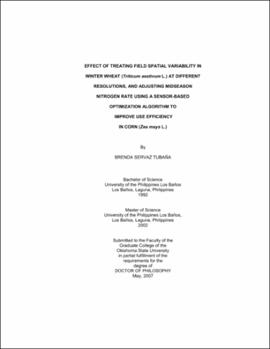| dc.contributor.advisor | Raun, William | |
| dc.contributor.author | Tubana, Brenda Servaz | |
| dc.date.accessioned | 2013-12-10T18:04:39Z | |
| dc.date.available | 2013-12-10T18:04:39Z | |
| dc.date.issued | 2007-05 | |
| dc.identifier.uri | https://hdl.handle.net/11244/7753 | |
| dc.description.abstract | Scope and Method of Study: For chapter one, resolution trials were conducted to determine the scale at which spatial variability in winter wheat should be treated using an in-season nitrogen fertilization optimization algorithm (NFOA). The treatments included variable N rate applications at three resolutions (0.84, 13.37, and 26.76 m2), a fixed N rate at 90 kg ha-1 applied preplant and midseason, and a check plot arranged in a completely randomized design with three replications. For chapter two, experiments were conducted to formulate an in-season NFOA to estimate midseason N rates that maximize corn growth and minimize inputs, and to determine the optimum resolution to treat spatial variability in corn. The experiment consisted of 13 treatments arranged in a randomized block design with three replications. Treatments included: a 134 kg N ha-1 fixed rate applied in split, preplant- and sidedress-only; a 67 kg N ha-1 fixed rate applied preplant- and sidedress-only; three NFOA-based midseason N rates (RICV-, RI- and flat-RICV-NFOA) with (67 kg N ha-1) and without preplant N; and two resolutions (0.34 and 2.32 m2) tested for RICV-NFOA only. | |
| dc.description.abstract | Findings and Conclusions: For chapter one, the NFOA-based N rates achieved a higher N use efficiency (NUE) value of 41% compared with 33% of the 90 kg N ha-1 fixed rate applied midseason. Treating spatial variability using NFOA at 13.4 m2 achieved the highest NUE value of 56%. Four out of six site years resulted in a higher net return ( 5 to 101 ha-1) when an NFOA approach was used. Treating spatial variability at 13.4 m2 using the NFOA resulted in increased NUE and net return. For chapter two, with 67 kg N ha-1 preplant application, midseason RI-NFOA-based N rates improved NUE to 64% when compared with 56% of the134 kg N ha-1 fixed rate split applied. The RI-NFOA midseason N rates resulted in higher grain yield and net return in three of six high yielding site years. In general, the use of midseason N rate recommendations based on N demand of predicted yield potential resulted in improved NUE and net return compared with fixed N fertilizer application at 134 kg N ha-1. | |
| dc.format | application/pdf | |
| dc.language | en_US | |
| dc.rights | Copyright is held by the author who has granted the Oklahoma State University Library the non-exclusive right to share this material in its institutional repository. Contact Digital Library Services at lib-dls@okstate.edu or 405-744-9161 for the permission policy on the use, reproduction or distribution of this material. | |
| dc.title | Effect of treating field spatial variability in winter wheat (Triticum aestivum L.) at different resolutions, and adjusting midseason nitrogen rate using a sensor-based optimization algorithm to improve use efficiency in corn (Zea mays L.) | |
| dc.contributor.committeeMember | Solie, John B. | |
| dc.contributor.committeeMember | Stone, Marvin L. | |
| dc.contributor.committeeMember | Edwards, Jeff | |
| osu.filename | Tubana_okstate_0664D_2239 | |
| osu.accesstype | Open Access | |
| dc.type.genre | Dissertation | |
| dc.type.material | Text | |
| thesis.degree.discipline | Soil Sciences | |
| thesis.degree.grantor | Oklahoma State University | |
